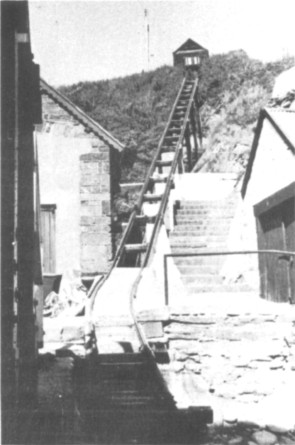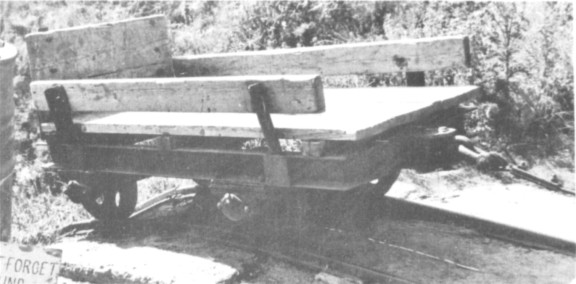
| THE INDUSTRIAL RAILWAY RECORD |
© APRIL 1969 |
A WELSH CLIFF RAILWAY
S. V. F. LELEUX
(Photographs by the Author)
The south-west tip of Wales is a rocky peninsula with a tiny bay (map reference 138/723251) at the extreme end. Half a mile away, across a stretch of rock-strewn water subject to strong tides, is the island of Ramsey, beyond which is another large area of rocks sufficiently dangerous to shipping to warrant the erection of a lighthouse. Above the bay is the ruined chapel of St Justinian, and in the bay is the house and slipway of the St David’s lifeboat. Below is the quay used for shipping goods to Ramsey island - food, fuel, fertilisers - and passengers embark from the foot of the lifeboat slip.
The road from St David’s ends just by the chapel, and the only way down to the beach (about 80ft below) is a long flight of steps. To carry all the supplies for the island down the steps would be laborious, so a small railway has been built. How old it is I do not know, but I was assured it is used daily and seems likely to remain so since no road can be built to replace it.
The gauge is 1ft 11½in and the length of the track about a hundred yards. The rolling stock consists of one wagon. I regret that I did not measure this, but I was very hot and tired after a somewhat perilous cliff walk. The wagon is hauled up by a 5.1 hp Petter petrol engine, and there is one horizontal guide roller at the top: it is just visible under the wagon. There are no lateral guides, in spite of the S−bend near the bottom. The rails are spiked direct to longitudinal battens with wooden cross spacers at intervals (like GWR broad gauge!) except at the level crossing and on the quay, where they are buried in concrete. The level crossing is near the foot of the steps, and is for the use of all persons going to or from the beach, the quay, or the lifeboat station, and is ungated! There are no buffer stops - at the top the rails stop at the door of the engine house, and at the bottom they disappear under water.


Upper - General view of the line from the pier.
Lower - The solitary item of rolling stock.
For the record ....
A ‘mini-loco’ designed by Motor Rail Ltd, of Bedford, specifically for operation in mines with narrow tunnels and galleries has won an initial order, worth more than £18,000, from the nationalised State of Ghana Gold Mine at Tarkwa. The order is for 15 of the new series G locomotives, which are approximately half the size of Motor Rail’s Simplex industrial loco.
(Board of Trade Journal, 2nd August 1968)
The Carron Ironworks Co (sic), situated at Falkirk, own 11 locomotives and operate 25 miles of private railway in and around the works. The Carron Co have also a number of locomotives working at their own collieries, which are situated in various parts of Dumbartonshire, Stirlingshire and Fifeshire. (The Locomotive Magazine, 31st January 1903)